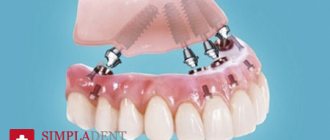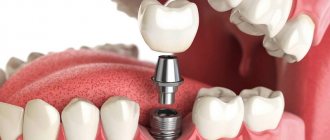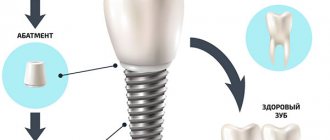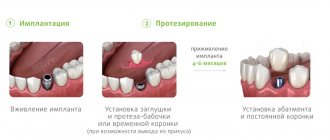Implantation is the replacement of a lost tooth with an artificial one. For an implant to function like a natural tooth, it must be securely secured. Unfortunately, as soon as we lose a tooth, the bone tissue begins to decrease. Over time, the atrophy becomes so pronounced that there is simply nowhere to insert the metal pin; there is not enough space for it.
In the upper jaw, bone loss is accompanied by a descent of the maxillary sinus membrane. As a result, there is not enough bone volume, and there is also a risk of membrane perforation during surgery.
Dentists have developed a bone grafting method that lifts the wall of the maxillary sinus. They called it sinus lifting, from the words “sinus” (maxillary sinus) and “lift.”
How it's going
Sinus lifting and implant installation are possible with open and closed methods. Whatever method the doctor chooses, it all starts with preparation. The implantologist assesses your general health and treats your gums if necessary. Blood tests make it possible to rule out infections and inflammatory processes. It is important to tell your doctor about allergic reactions.
A panoramic image (orthopantomogram) and CT will help assess the condition of the jaw, indications for implantation and augmentation. Installation of implants immediately after sinus lift is possible if the bone thickness is 5 mm or more. A CT scan will also show the presence of inflammatory processes in the maxillary sinus, cysts or tumors for which surgery cannot be performed.
Methodology
Using the sinus lift technique with simultaneous implantation requires careful preparation and examination of the patient. Before treatment, the doctor must make sure that there are no contraindications, select an anesthetic, and choose surgical tactics and implants. All stages of surgical planning take place taking into account the patient’s wishes. Stages of bone augmentation and installation of structures:
- Complete pain relief.
- An incision is made and the gum is peeled off.
- Access to the maxillary sinus is created.
- Artificial bone material is introduced.
- Implants are installed.
- The flap is placed on the gum and the tissue is sutured.
- The patient is given recommendations:
- Oral baths with an aqueous solution of Chlorhexidine 0.02% (Paradontax) from tomorrow 3-4 times a day after meals for 5 seconds
- Do not blow your nose (dry your nose), or sneeze with your mouth open. Do not fly for 2 weeks
- Refusal of active physical activity for 3 days. Do not take a warm bath or go to the sauna for 2 weeks
- Stop smoking for 2 weeks
- Brush your teeth in the surgical area only with a surgical soft toothbrush starting tomorrow for 10 days.
- Medication support in the postoperative period
To the list of posts
Implantation with closed sinus lift
The skill of the doctor plays a decisive role in the success of any operation, but with a closed protocol, it is doubly important. The doctor approaches the membrane blindly; a lot depends on experience and intuition.
A bed for the implant is formed in the bone. Through it, the membrane is lifted with a special tool. The resulting cavity is filled with bone material and compacted. Then the pin is screwed in. The screw threads of these pins further compact the bone material as they move, increasing primary stability.
1 - formation of the hole, 2 - raising the bottom of the sinus, 3 - filling with bone material, 4 - installation of the implant
Features of rehabilitation after bone block transplantation
When growing bone using the autotransplantation method, donor material is taken from the patient’s body and transplanted to a new location. Therefore, a significant difference from other methods of osteoplasty is that after the operation the patient is left with not one, but two intervention sites. In this case, the patient needs to be as attentive as possible in relation to the oral cavity, carry out hygienic procedures with caution, do not touch the injured areas with a brush and do not pick them with the tongue.
Open sinus lift with immediate implantation
This protocol seems more complex, but in fact the implantologist sees the surgical field, the risk of perforation is low.
The doctor creates a surgical window in the bone, lifts the shell, installs a protective membrane, and fills the hole with bone material. Then the implant is installed and the wound is sutured.
1 - formation of a hole in the bone, 2 - raising the bottom of the sinus, 3 - filling with bone material, 4 - installation of an implant
Is it possible to perform implantation without bone grafting?
The only alternative to bone grafting (excluding prosthetic methods without the use of implants, i.e. removable and bridge prostheses) is a one-stage implantation protocol with immediate loading. However, without a bone augmentation procedure, it is used only for multiple restorations, since in order to fully support the prosthesis in conditions of bone tissue atrophy, it is necessary to install at least three implants both for a segment of teeth and for prosthetics of a full row.
Read more about methods of dental implantation in 1 day WITHOUT bone grafting >>>
Rehabilitation
Recovery takes about a week
.
The duration of the rehabilitation period depends on the individual characteristics of the body and the type of operation. With an open protocol, swelling is greater and lasts longer. When closed, everything returns to normal in 3-4 days
.
On these days it is necessary:
- strictly follow the instructions;
- take antibiotics, analgesics;
- rinse your mouth with antiseptics;
- avoid hot, cold;
- eat soft, crushed food;
- limit physical activity;
- avoid temperature changes.
One week after surgery
Along with the end of the first week after surgery, the end of the rehabilitation period is approaching. This means that you can gradually return to your normal lifestyle. You can already start training, but increase the load gradually. If there is no pain, the wound has healed, and the stitches have been removed, you can start eating more solid food - focus on your own well-being. If it hurts, don't eat! Try not to overstress the operated area.
Similarly with hygiene - after a week you need to move on to full hygiene. But if it hurts, brush only those teeth that are not in contact with the wound. Use a soft-bristled brush. Be extremely careful and attentive.
Possible complications
Complications are possible with any surgical intervention; installation of implants after sinus lift is no exception. The most common problem is perforation of the maxillary sinus membrane. A small perforation is not so dangerous, there is no reason to refuse the operation, but if the diameter is large, the procedure will have to be stopped. Also happens:
- Sinusitis
. Inflammation of the sinuses with accumulation of pus. - Fistula formation
. When an infection enters a surgical wound, it “eats” the bottom of the maxillary sinus. A passage into the oral cavity is formed. - Bleeding
. As a result of vascular damage, severe blood loss can occur. - Implant rejection
. The survival rate of implants from well-known manufacturers is 99%. Unfortunately, there are cases when the artificial root is rejected by the body. Therefore, it is important to tell your doctor about all diseases, allergies, and body characteristics in order to exclude the possibility of rejection.
A good clinic has equipment and tools to eliminate the consequences, but the main thing is prevention. In this case, the implantologist is highly qualified. The more experienced the doctor, the less likely he is to make a mistake.
What is this
A surgical procedure performed to increase the amount of bone tissue in the upper jaw.
In the cranium around the nose there are large maxillary sinuses. They are located immediately above the roots of the lateral chewing teeth. The inside of the sinuses are covered with a thin protective shell, which is lifted and the formed space is filled with material.
As a result of the operation, surgeons obtain sufficient thickness for reliable installation of the implant.
Note! The term “lifting” is used in medical cosmetology, but it has nothing to do with sinus lifting in dentistry.
A cosmetic procedure is a series of injections with fillers containing hyaluronic acid, which “tightens” the oval of the face and smoothes out facial wrinkles.
Contraindications for surgery
Contraindications to closed or open sinus lift during implantation can be relative or absolute. In the first case, surgery is possible, but not immediately, but after treatment of existing pathologies and recovery after it. In the second, a complete ban is imposed on surgical interventions. So, the following contraindications will be relative:
- poor oral hygiene, a large amount of tartar and plaque on the teeth,
- acute diseases: runny nose, sinusitis, ARVI,
- alcohol and smoking abuse in a given period of time,
- pregnancy, lactation,
- recent sinus surgery.
Absolute contraindications include severe illnesses in the acute stage or immediately after treatment (heart and vascular diseases, head and neck oncology), uncontrolled diabetes mellitus, severe bleeding disorders, and serious mental disorders. As well as chronic ENT pathologies that cannot be completely cured (sinusitis, sinusitis, polyps), defects of the maxillary sinus, the minimum amount of remaining bone is literally 2-3 mm.
Why do you need to combine operations?
Combining implantation and sinus lift offers several key benefits. Firstly, this is a reduction in surgical interventions that extend over time - less tissue trauma, fewer anesthetics and only 1 rehabilitation period. Secondly, there will be an implant (analogous to a root) inside the planted bone, so the bone chips have a better chance of taking root - it will completely become the basis for the young own bone around the implant. For comparison, conventional osteoplastic procedures (without simultaneous implantation) have an effectiveness of only 40-60%, because the bone either does not take root or takes root poorly. Such patients have to go through extensions one or two more times.
“I wanted to get an upper tooth implant for a long time, but there was no time. Moreover, the hole is on the side and is not visible. But it took a long time, as it turned out. The bone in this place was gone, and we had to build it up. Only after this the doctor was able to place the implant. And the crown was done only six months later. It turns out that all this torture and treatment dragged on for almost a year and a half.”
Karina_91, review from the woman.ru forum
Features of preparation for treatment
Before undergoing a sinus lift for dental implants, you need to undergo an examination and draw up a treatment plan. Because diagnosis and careful planning are the key to the success of operations and will eliminate possible errors and complications. We will consider below what the patient will need to do before restoring teeth:
- undergo an X-ray examination: it is better to have a cone beam or multislice computed tomography, because they provide a three-dimensional image that reflects the true state of the bone tissue and maxillary sinuses,
- cure dental diseases: caries, pulpitis, stomatitis,
- undergo professional oral hygiene: remove tartar and plaque, which are a source of accumulation of microbes,
- cure ENT pathologies: rhinitis, sinusitis, sinusitis, etc.,
- undergo tests: the operation is recommended if there are no inflammatory processes in the body, blood clotting disorders, or high blood pressure - otherwise complications are possible.
Treatment planning is carried out by a dental surgeon (implantologist), who, based on CT images, selects suitable types of implants, determines the exact location of their installation and the depth of immersion, taking into account the augmented bone. Also, the doctor will be able to “rehearse” a future intervention in the virtual space.









